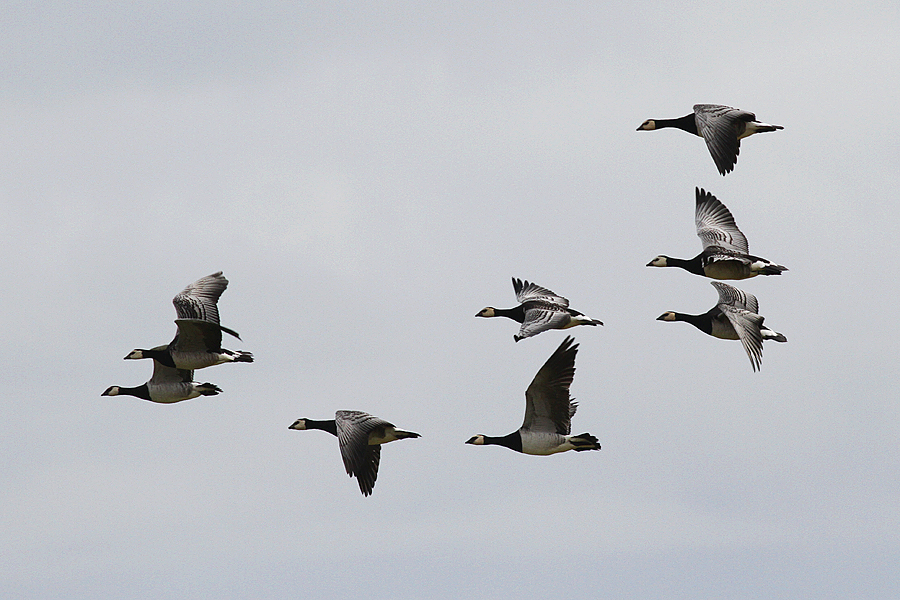There are a number of different goose species that visit Shetland, the most common being the Greylag Goose which has become a resident species in recent years with a number of individuals staying into the spring and summer to breed. The geese species can be broadly split into two groups, the ‘grey’ geese species in the genus Anser and those within the Branta genus such as the Barnacle Goose. It can be very difficult to identify one species from another, especially the ‘grey’ geese which look very similar and are often seen in mixed flocks when on the ground.
This article will take you through each of the species detailing the main features that tell each one apart. The different species also have different calls which can be a good way to identify flocks in flight.
Need ID help in the field? Download our handy ID leaflet here produced with assistance from Shetland Bird Club.
Resident
Greylag Goose (Anser anser)–
The only resident goose in Shetland. Historically they were passage migrants, arriving in the isles in late autumn and overwintering before heading away further north to breed in the spring. In recent years, they have started to appear in larger numbers, flocks of several hundred can be gathered in fields in autumn and winter. There were records of breeding pairs in Unst and Fetlar in the 1970’s but in the late 1990’s the number of pairs staying in the isles to breed dramatically increased and has been steadily increasing since. This increase is thought to coincide with a 250% rise in grassland areas in Shetland from 7,000ha in 1981 to almost 20,000ha in 1996.
Identifying features- largest/ bulkiest of the ‘grey’ geese species with a large orange beak and pink legs. In flight their upper wings are pale grey in colour. Their call is similar to that of domestic species with a loud, raw ‘ank-ang-ang’ sound, although their repertoire is quite varied.

Diliff, CC BY-SA 3.0 via Wikimedia Commons
Common Migrants
Pink-footed Goose (Anser brachyrhynchus)–
A common passage migrant. Large flocks, sometimes in their thousands, pass over Shetland heading south in late September/ early October but the majority do not land. Those that do make a pit stop in the isles can be spotted in amongst the flocks of Greylag Geese. A handful of individuals have overwintered in Shetland most years usually in the Dunrossness area. Pink-footed Geese also migrate through Shetland in the Spring but in much lower numbers.
Identifying features- Smaller than Taiga Bean Goose and equal in size to Tundra Bean Goose but as its name suggests, they have pink legs in comparison to the bean geese (although this can be difficult to establish at a distance). They have a small, short, dark beak with a pink band, and a dark head and neck. Call similar to the bean geese species but of higher pitched ‘ca-ca-ca’ sound.
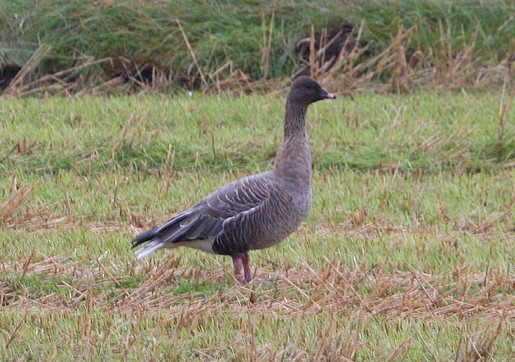
Copyright: Rob Fray
Barnacle Goose (Branta leucopsis)–
Another common passage migrant which passes over without often making landfall. Peak numbers seen from end September to early October but smaller numbers continuing until early November. Occasionally, large flocks of several hundred do land in the isles, this autumn (2020) a group of approximately 850 were seen on the ground in Scatness.
Identifying features- easily identifiable medium sized goose with white under belly and grey, black and white barred upperparts. Black neck, white face with a small black beak. Very vocal when in flight making a single ‘kaw’ sound.

Copyright: Rob Fray
Scarce Visitors
White-fronted Goose (Answer albifrons)-
A winter visitor in Shetland, their arrival is usually linked to cold weather on the European mainland which encourages them to seek milder conditions. In a usual year between 10 and 40 individuals arrive in the Isles, however some years there are more, such as 2011, when at least 300 were sighted throughout the islands in November including a flock of 80 at Spiggie.
Identifying features- medium sized ‘grey’ goose species, smaller than a Greylag, similar in size to a Pink-footed Goose. They are browner in colour than the other ‘grey’ goose species with prominent black patches on its underbelly, bright orange legs, pinkish beak and the white blaze around the face between the eye and the beak which gives it its name. Their call is described as having a laughing quality to it and being more high-pitched and musical than other species. Often heard making this ‘Kyu-yu-yu’ sound when in flight.
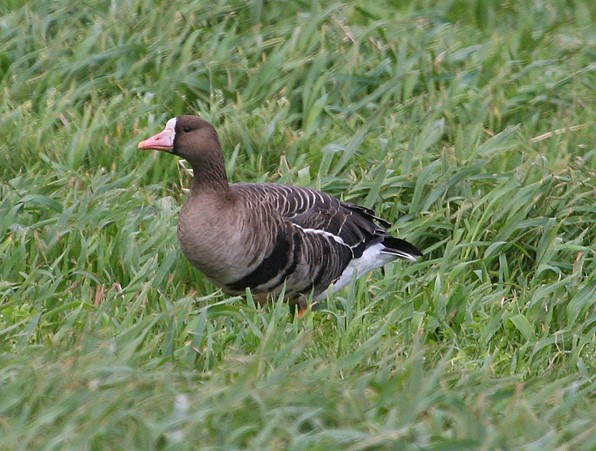
Copyright: Rob Fray
Tundra Bean Goose (Anser serrirorstris)-
Bean geese were recently split into two unique species, the Tundra Bean Goose and the Taiga Bean Goose. They are very difficult to distinguish from one another, the only real noticeable difference is the size and shape of the bill. Most likely to be seen in the winter between November and March.
Identifying features- the Tundra Bean Goose has a shorter, heavier bill and the orange/yellow colouration is limited to a small band around the bill. The Tundra Bean Goose is also slightly smaller than the Taiga Bean Goose, similar in size to the Pink-footed Goose. Call is a trumpeting ‘ung-unk’ similar to Pink-footed but deeper pitched.

Brent Goose (Branta bernicla)-
A very scarce migrant in Shetland with only a handful of individuals each year. Most commonly sighted in the winter months between September and April. Two subspecies occur, the Dark-bellied Brent Goose (B.b.bernicla) and the Pale-bellied Brent Goose (B.b hrota). The later is more commonly seen in Shetland.
Identifying features- in the same genus as the Barnacle Goose, the Brent Goose is slightly smaller and browner in colour, they have a dark neck similar to the Barnacle Goose but lack the white colouration on their face. Noisy and repetitive ‘rhut’ call.
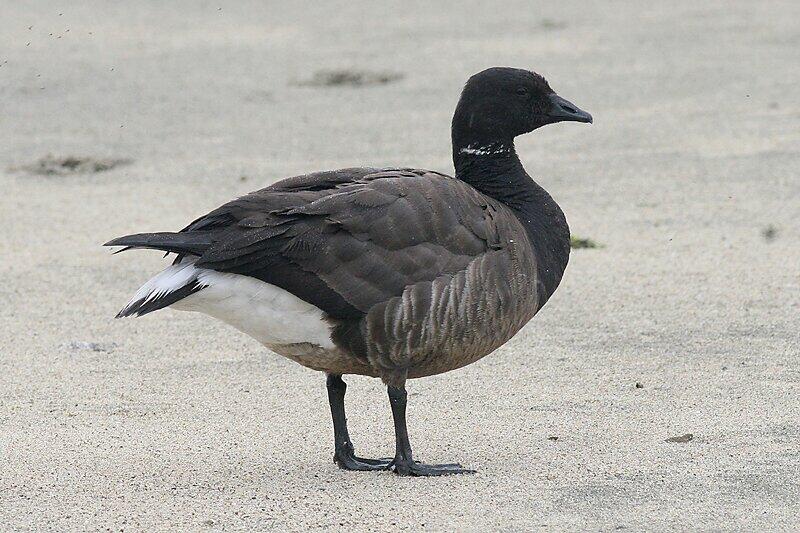
Rare Visitors
Canada Goose (Branta canadensis)-
Introduced into the UK from America and now common in most of the UK but rare in Shetland. Most likely to be seen from April-June.
Identifying features- large, easily identifiable goose. Body mainly brown in colour. Long neck with black colouration which does not extend down onto the breast as it does in the Barnacle Goose. Also, a white patch on the head that does not extend up and over the eye. Vocal goose with a repetitive ‘awr-lut’ with the second syllable higher pitched.

Dr. Raju Kasambe, CC BY-SA 3.0 via Wikimedia Commons
Taiga Bean Goose (Anser fabalis)-
A very rare vagrant from Europe, the last record in Shetland was of two individuals in 2016 (one in Whalsay in February and one in Sumburgh in October). Easily confused with the Tundra Bean Goose.
Identifying features- the bill is longer and slimmer than that of the Tundra Bean Goose with a larger proportion of orange/yellow colouration. The Taiga bean goose is also slightly larger with a longer neck in comparison to the Tundra Bean Goose, more similar in size to a Greylag Goose. Call indiscernible from that of the Tundra Bean Goose (trumpeting ‘ung-unk’ similar to Pink-footed but deeper pitched).
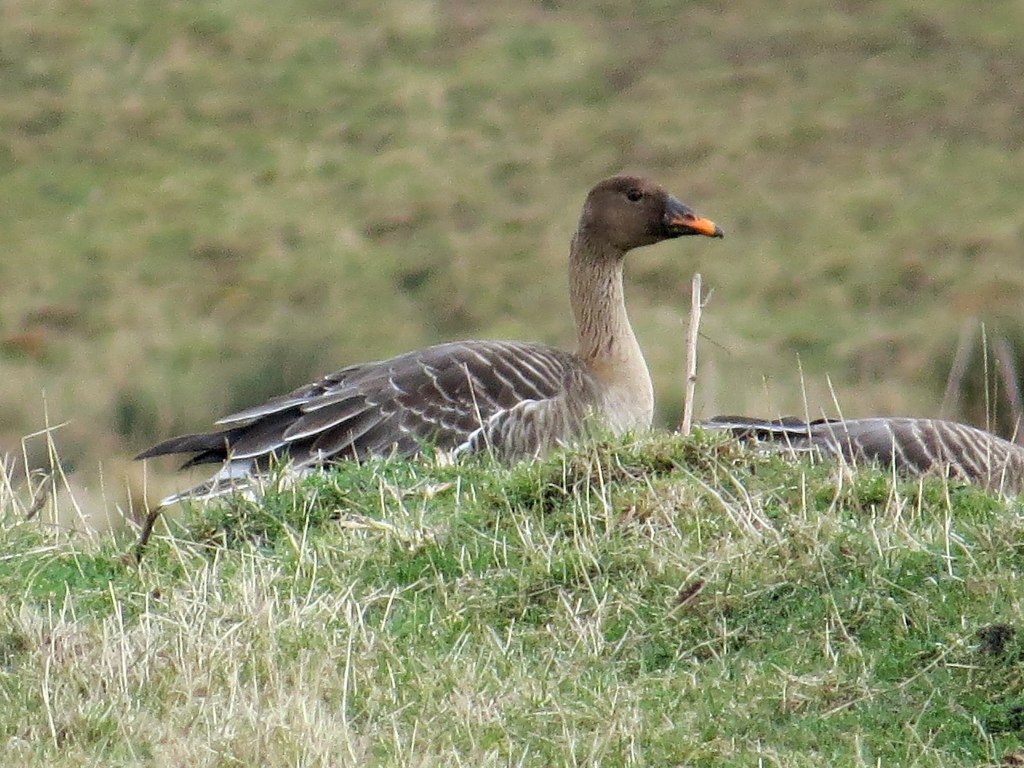
MPF, CC BY-SA 3.0 via Wikimedia Commons
Snow Goose (Anser caerulascens)-
Very rare species in Shetland. Individuals arrive on occasion, but their true status is confused by the presence of a feral breeding population in other areas of the UK meaning we can never be sure if they are completely wild.
Identifying features- medium sized, comparable to Pink-footed Goose. Snow Geese occur in two colour morphs: White with black wing tips or blue/grey body and wings with a white head and tail tip. Crackling call ‘ak-ak’
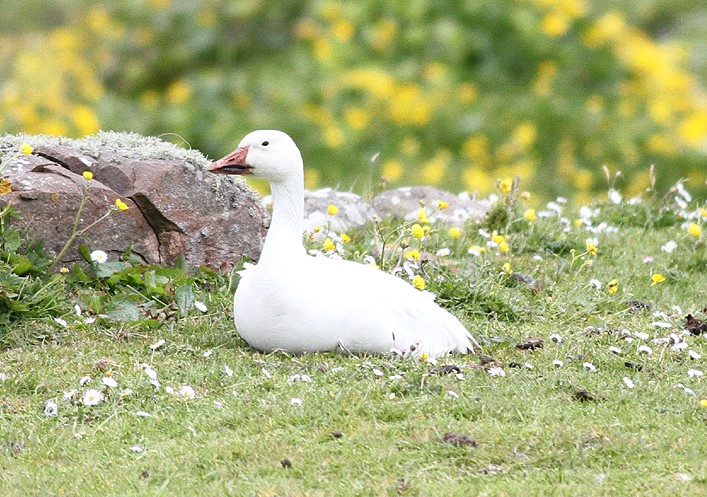
Copyright: Rob Fray
It should be noted that there are many local populations of domesticated geese around Shetland that may be spotted in fields and on lochs. As most domestic geese are thought to originate from the Greylag Goose species, they are similar in appearance but will often have markings of white anywhere on their body/head.
Any records of goose sightings can be submitted to the Shetland Community Wildlife Group at shetlandcommunitywildlife@outlook.com or directly to the Shetland county recorder at recorder@shetlandbirdclub.co.uk
If possible records should state:
- Date
- Species
- Number of Individuals
- Location
- Grid ref (not essential)
- Observer name
Photographs are always welcomed and can be especially useful for evidencing rare and scare species.

